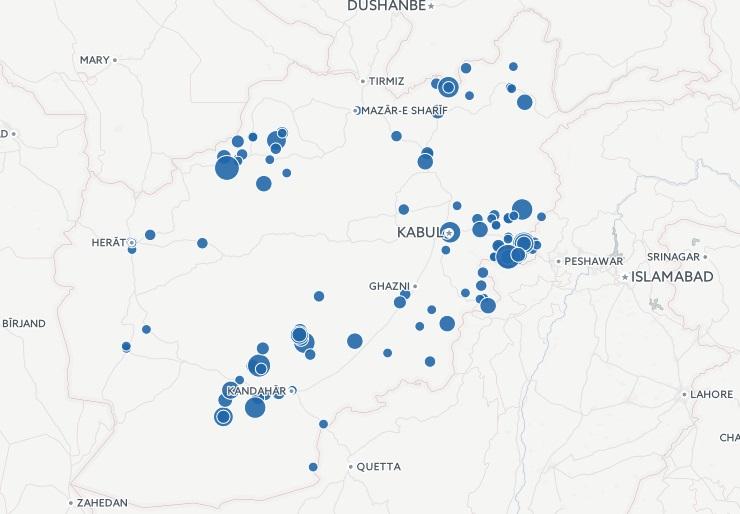KABUL (Pajhwok): As many as 1,400 people were killed and wounded in 139 attacks in Afghanistan last month, showing a 14 percent increase over previous month’s casualties.
Pajhwok Afghan News reports show there was no letup in violence this winter, with the conflict once again claiming precious lives of many Afghans.
Pajhwok Afghan News daily reports on clashes and fighting shows 25 of the country’s total 34 provinces witnessed incidents of violence in February.
Half of the casualties in February resulted from cross firing between militants and security forces. Twenty-six people among every 100 people suffered casualties in airstrikes, eight in targeted attacks, seven in suicide attacks, as many in different blasts and two suffered causalities in roadside blasts.
Half of casualties result from ground battles In February incidents included 53 clashes between security forces, Daesh and Taliban, 35 incidents of targeted killing, 30 airstrikes and 12 blasts including five roadside blasts and four suicide blasts.
Half of these attacks happened in Nangarhar, Faryab and Helmand provinces and the remaining in 22 provinces. Last month, 40 attacks happened in Nangarhar, 14 in Faryab and 13 in Helmand provinces and the rest in Balkh, Bamyan, Logar, Samangan and Zabul provinces.
There were no reports about clashes from Panjsher, Daikundi, Maidan Wardak, Ghor, Nimroz, Nuristan, Parwan, Sar-i-Pul and Badghis provinces. In January, most of the attacks happened in Helmand, Nangarhar, Faryab, Zabul and Badakhshan provinces.
The same month Pajhwok did not receive violence-related reports from Maidan Wardak, Panjsher, Bamyan, Daikundi, Paktia, Ghor, Nuristan, Kunar and Laghman provinces.
Casualties Reports show 834 people were killed and another 609 wounded during February’s 139 attacks.
The dead and wounded included insurgents, government forces and civilians, however Pajhwok could not publish exact number of casualties because various sources made different accounts and the differentiation was impossible.
In February, the most attacks were carried out Feb 1st and 20th (11 attacks each), however February 28 was the deadliest day when 128 people suffered casualties.
Nearly half part of last month’s casualties happened in Nangarhhar and Faryab provinces and among each 36 people killed or wounded, four each were in Uruzgan and Helmand, two each in Kabul and Laghman, and one each in Kandahar, Paktika, Kunduz and Khost provinces.
Inaccurate predictions about reduction in attacks
Pajhwok Afghan News tally shows about 70 people averagely suffered casualties on a daily basis in the last five months of 2016. More than one-third of the casualties occurred in October. Attacks and casualties declined until the end of December and the conflict then again intensified.
A military analyst and a retired general, Attiqullah Amarkhel, said war tactics had changed. “In the past years, the conflict would decline but now the anti-government forces have changed tactics.”
He said the insurgents had changed tactics and intensified their attacks in areas with apt weather conditions in order to show the world that they were strengthening each day.
He said militants fleeing Pakistan into Afghanistan encouraged some senior Taliban leaders to come to Afghanistan and keep the war going in areas fit for fighting. He said insurgents this winter were not only active in warm areas but they were more or less active in cold areas as well.
The Ministry of Defence (MoD) spokesaman, Maj. Gen. Dawlat Waziri said: “It is unfortunate that the sworn-enemies of Afghanistan are yet to shun violence and the support they receive hasn’t reduced. I hope we see no violence next year.”
He said the insurgents had intensified attacks in order to show the world that they were still strong and could fight. Waziri said operations which were carried out this winter had good results. Many enemy plots were foiled and they were defeated in operations in Nangarhar, Faryab, Helmand, Uruzgan, Kandahar, Zabul, Ghazni and other provinces.
Fear of possible uptick in the conflict Farid Ahmad Stanikzai, a resident of Karta-i-Char area of Kabul city, said militant attacks in past winters would decline but fighting continued this winter, rising concerns about deadly battles in spring.
He said militants could conduct more attacks by hiding in trees and jungles being grown in spring and summer.
“Most of the war victims are civilians. Many more people will die and get maimed if the situation worsens because the conflict has reached residential areas. We ask the warring sides to stop fighting and taking lives from innocent Afghans,” he said.
Wranga, a resident of Aino Mina Township of Kandahar city, said civilians would suffer casualties in the coming year as yet if the war continued. “Security situation is very bad if you go to districts, both the warring sides blindly exchange bullets and as a result civilians are killed,” she said, asking the warring parties to resolve their problem through negotiations.
On people’s fear about a possible war escalation, military affairs expert, Amarkhel, said: “If we assess the overall security situation of Afghanistan then the people are right, we saw increased militant attacks this winter compared to the past.”
However, Waziri hoped peace would prevail in Afghanistan and that the Afghan forces were fully prepared to deal with militants next year.
He said if Pakistan cooperated sincerely and acted on its promises, he was sure the conflict in Afghanistan would come to an end soon.
Visits: 11









GET IN TOUCH
NEWSLETTER
SUGGEST A STORY
PAJHWOK MOBILE APP